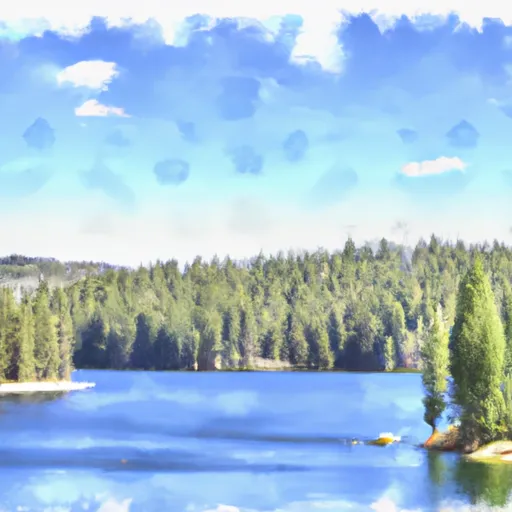-
 Snoflo Premium
Snoflo Premium
Get unlimited access to all our content
With no Ad interruptions! - Start Your Free Trial Login with existing account
Shaver-Lake
Eden Index
Climate
9.6
•
Recreation
9.3
•
Community
•
Safeguard
7.1/10

Shaver Lake is a picturesque mountain community located in Fresno County, California. Situated at an elevation of 5,500 feet, the region boasts a pleasant Mediterranean climate characterized by warm, dry summers and cool, wet winters. Summers are mild, with average temperatures ranging from the mid-70s to the low 80s Fahrenheit, making it an ideal escape from the scorching heat of the Central Valley. The winter months bring occasional snowfall, transforming the area into a winter wonderland for outdoor enthusiasts.
The main attraction of Shaver Lake is undoubtedly its namesake, a beautiful reservoir fed by the pristine waters of the Sierra Nevada. The lake's hydrology constituents include the South Fork San Joaquin River and numerous mountain streams, ensuring a steady flow of crystal-clear water year-round. This makes Shaver Lake a popular destination for fishing, boating, and water sports. Additionally, the surrounding forests offer ample opportunities for hiking, mountain biking, and camping, allowing visitors to immerse themselves in the breathtaking scenery of the Sierra National Forest.
In summary, Shaver Lake, California provides a delightful climate, refreshing hydrology constituents, and a myriad of outdoor recreation opportunities, making it an idyllic destination for nature lovers and adventure seekers alike.
What is the Eden Index?
The Snoflo Eden Index serves as a comprehensive rating system for regions, evaluating their desirability through a holistic assessment of climate health, outdoor recreation opportunities, and natural disaster risk, acknowledging the profound impact of these factors on livability and well-being.
Climate Health Indicator (CHI): 9.6
Shaver-Lake receives approximately
943mm of rain per year,
with humidity levels near 73%
and air temperatures averaging around
10°C.
Shaver-Lake has a plant hardyness factor of
8, meaning
plants and agriculture in this region tend to thrive here all year round.
By considering the ideal temperature range, reliable water supplies, clean air, and stable seasonal rain or snowpacks, the Climate Health Indicator (CHI) underscores the significance of a healthy climate as the foundation for quality living.
A healthy climate is paramount for ensuring a high quality of life and livability in a region, fostering both physical well-being and environmental harmony. This can be characterized by ideal temperatures, reliable access to water supplies, clean air, and consistent seasonal rain or snowpacks.
Weather Forecast
Streamflow Conditions
San Joaquin
Area Rivers
San Joaquin
Snowpack Depths
San Joaquin
Reservoir Storage Capacity
San Joaquin
Groundwater Levels
Recreational Opportunity Index (ROI): 9.3
The Recreational Opportunity Index (ROI) recognizes the value of outdoor recreational options, such as parks, hiking trails, camping sites, and fishing spots, while acknowledging that climate plays a pivotal role in ensuring the comfort and consistency of these experiences.
Access to outdoor recreational opportunities, encompassing activities such as parks, hiking, camping, and fishing, is crucial for overall well-being, and the climate plays a pivotal role in enabling and enhancing these experiences, ensuring that individuals can engage in nature-based activities comfortably and consistently.
Camping Areas
| Campground | Campsites | Reservations | Toilets | Showers | Elevation |
|---|---|---|---|---|---|
| Choinumni | 36 | 557 ft | |||
| Kirch Flat - Pine Flat Lake | 17 | 1,007 ft | |||
| Bretz | 12 | 3,281 ft | |||
| Trimmer - Pine Flat Lake | 10 | 938 ft | |||
| Gigantea | 11 | 6,358 ft | |||
| Pine Flat Rec Area | 52 | 586 ft | |||
| Island Park - Pine Flat Lake | 97 | 1,157 ft | |||
| Buck Meadow | 9 | 6,758 ft | |||
| Camp 4 - Yosemite National Park | 35 | 1,048 ft | |||
| Camp 4 1/2 | 5 | 1,082 ft |
Nearby Ski Areas
Catastrophe Safeguard Index (CSI):
The Catastrophe Safeguard Index (CSI) recognizes that natural disaster risk, encompassing floods, fires, hurricanes, and tornadoes, can drastically affect safety and the overall appeal of an area.
The level of natural disaster risk in a region significantly affects safety and the overall livability, with climate change amplifying these risks by potentially increasing the frequency and intensity of events like floods, fires, hurricanes, and tornadoes, thereby posing substantial challenges to community resilience and well-being.
Community Resilience Indicator (CRI):
The Community Resilience Indicator (CRI) recognizes that education, healthcare, and socioeconomics are crucial to the well-being of a region. The CRI acknowledges the profound impact of these elements on residents' overall quality of life. By evaluating educational resources, healthcare accessibility, and economic inclusivity, the index captures the essential aspects that contribute to a thriving community, fostering resident satisfaction, equity, and social cohesion.

